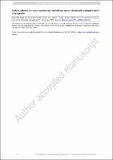| dc.contributor.author | Kolel-Veetil, Manoj | |
| dc.contributor.author | Sen, Ayusman | |
| dc.contributor.author | Buehler, Markus J. | |
| dc.date.accessioned | 2022-02-10T22:58:38Z | |
| dc.date.available | 2021-11-01T14:33:47Z | |
| dc.date.available | 2022-02-10T22:58:38Z | |
| dc.date.issued | 2021-06 | |
| dc.date.submitted | 2021-01 | |
| dc.identifier.issn | 2059-8521 | |
| dc.identifier.uri | https://hdl.handle.net/1721.1/136850.2 | |
| dc.description.abstract | Abstract
Coronaviruses COVID-19, SARS-CoV and NL63 use spikes in their corona to bind to angiotensin converting enzyme 2 (ACE2) sites on cytoskeletal membranes of host cells to deliver their viral payload. While groups such as disulfides in ACE2’s zinc metallopeptidase, and also in COVID-19’s spikes, facilitate such binding, it is worth exploring how similar complementary sites on materials such as polymers, metals, ceramics, fabrics, and biomaterials promote binding of viruses and bacteria and how they could be further engineered to prevent bioactivity, or to act as agents to collect viral payloads in filters or similar devices. In that vein, this article offers a perspective on novel tools and approaches for chemically and topologically modifying most utilitarian surfaces via defensive topological vibrational engineering to either prevent such adhesion or to enhance adhesion and elicit vibrational characteristics/’musical signatures’ from the surfaces so that the structure of the binding sites of viruses and bacteria is permanently altered and/or their cellular machinery is permanently disabled by targeted chemical transformations.
Graphic abstract | en_US |
| dc.publisher | Springer Science and Business Media LLC | en_US |
| dc.relation.isversionof | https://doi.org/10.1557/s43580-021-00079-0 | en_US |
| dc.rights | Creative Commons Attribution-Noncommercial-Share Alike | en_US |
| dc.rights.uri | http://creativecommons.org/licenses/by-nc-sa/4.0/ | en_US |
| dc.source | Springer International Publishing | en_US |
| dc.title | Surface adhesion of viruses and bacteria: Defend only and/or vibrationally extinguish also?! A perspective | en_US |
| dc.type | Article | en_US |
| dc.contributor.department | Massachusetts Institute of Technology. Laboratory for Atomistic and Molecular Mechanics | |
| dc.relation.journal | MRS Advances | en_US |
| dc.eprint.version | Author's final manuscript | en_US |
| dc.type.uri | http://purl.org/eprint/type/JournalArticle | en_US |
| eprint.status | http://purl.org/eprint/status/PeerReviewed | en_US |
| dc.date.updated | 2021-07-01T04:11:17Z | |
| dc.language.rfc3066 | en | |
| dc.rights.holder | This is a U.S. government work and not under copyright protection in the U.S.; foreign copyright protection may apply | |
| dspace.embargo.terms | Y | |
| dspace.date.submission | 2021-07-01T04:11:17Z | |
| mit.journal.volume | 6 | en_US |
| mit.journal.issue | 13 | en_US |
| mit.license | OPEN_ACCESS_POLICY | |
| mit.metadata.status | Authority Work Needed | en_US |
